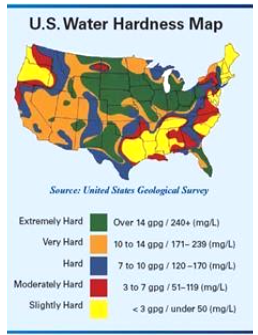Fresh water supplies are grouped into two categories, groundwater and surface water. Some of the water reaching the ground seeps down through the surface to the underground streams and lakes and is referred to as groundwater. Water on the surface flows across the soil and collects into brooks, streams, rivers, ponds or lakes. This source is referred to as surface water.
Because groundwater from shallow or deep wells is in contact with the rocks and soil for a longer period of time as it percolates down through the various layers of soil and rock, it generally contains a higher amount of dissolved solids than does surface water.
Surface water, on the other hand, will contain a higher amount of suspended solids as the flowing water picks up mud, dust, pollen and other small particles. As pointed out earlier, the types of impurities found in water depend on what the water contacts. The amount that it contains depends on contact time. The amount of impurities in water is usually measured in parts per million (ppm) by weight.
All natural water contains various types and amounts of impurities. Since impurities in water can cause problems in boilers, cooling towers and closed loops, careful consideration must be given to the quality of the water used for this purpose.
For more information on common boiler problems, click here.
Water is an excellent solvent and tends to dissolve the rocks and soil it contacts. Water absorbs gases from the atmosphere and soil. It also picks up suspended matter as it flows across or percolates down through the ground. In general, the type of impurities water contains depends on what it contacts. The amount of impurities depends on contact time.
The impurities in water can be classified in three broad groups. Dissolved solids are the impurities, primarily minerals, which are in a dissolved state. That is, they do not settle out of solution. Dissolved solids may stain or discolor the water, but remain transparent. Most naturally occurring water contains some calcium carbonate, calcium sulfate, magnesium sulfate, silica, sodium chloride, sodium sulfate and small quantities of iron, manganese, fluoride, aluminum and other substances.

Water that contains large amounts of the metals calcium and magnesium is referred to as hard water. The amount of hardness in natural water may vary from less than 5 parts per million to over 500 parts per million.
An average surface water supply will contain about 95 ppm of total hardness as opposed to an average of about 200 ppm for groundwater supplies. Since calcium and magnesium compounds in solution are relatively insoluble in water, they tend to precipitate out of solution and form deposits in cooling water systems. Deposits insulate heat exchange surfaces and reduce the operating efficiency of the system. While all impurities found in water must be taken into consideration when used in a cooling system, special attention must be given to hardness.
To learn more about how hard water affects cooling towers, click here.
Water treatment chemicals used to protect metal against corrosion, prevent scale deposits and inhibit microbiological growth are added to the water in the form of dissolved solids. The amount of solids added by water treatment specialists varies from 50 ppm in most cooling tower systems to over 3,000 ppm in certain closed loop systems.